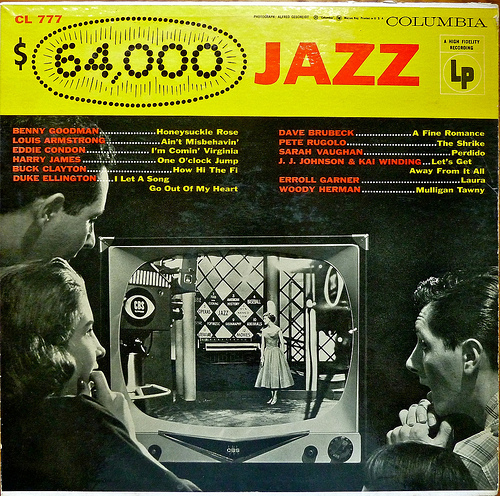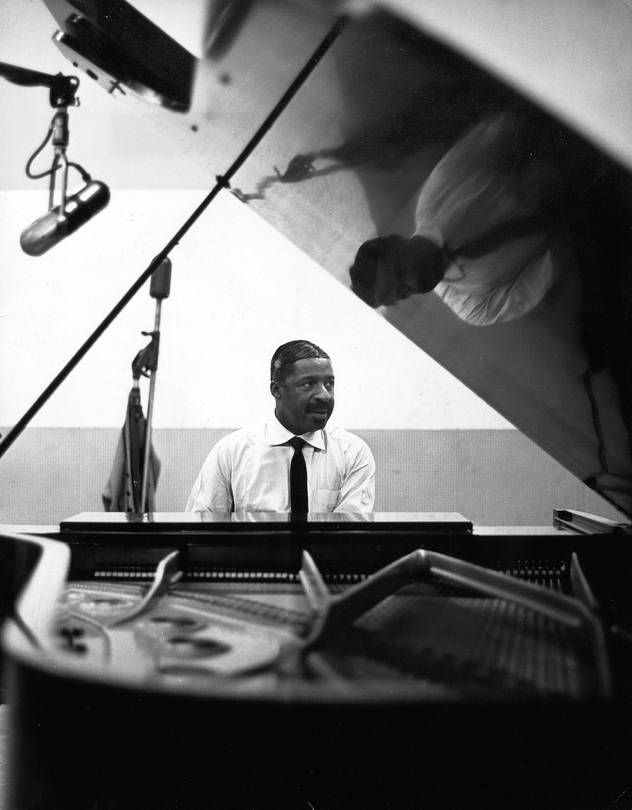Various forms of the records-that-changed-my-life meme have been making the rounds lately, so I came up with my own version, which I call “The Twenty-Five Record Albums That Changed My Life.” Throughout the coming month, I’ll write about one of these albums each weekday in the rough order in which I first heard them.

I wrote a long blog posting about $64,000 Jazz in 2013, for it was, unlikely as it may sound, one of the record albums that would do the most to shape my adult musical tastes. Here’s part of what I wrote back then.
* * *
The first of the big-money game shows, The $64,000 Question was so widely viewed that it actually displaced I Love Lucy as America’s most popular TV series, the first and only show ever to do so. The Rev. Alvin L. Kershaw, an Episcopal minister, won $32,000 in 1955 (the equivalent of $278,810 today) answering questions about jazz. Columbia thereupon released $64,000 Jazz, an anthology of performances by twelve of the label’s top-selling jazz artists. What the show’s unsuspecting viewers didn’t know was that it was rigged, a fact whose disclosure helped to trigger the nationwide scandal that was later portrayed by Robert Redford in Quiz Show. (It’s not known whether Rev. Kershaw, who died in 2001, was one of the crooked contestants.) Not surprisingly, $64,000 Jazz went out of print shortly after the program was cancelled, and eventually it became something of a collector’s item.
Needless to say, I knew none of this in 1968, the year in which I found Columbia CL 777 buried among my father’s old records. What interested me about $64,000 Jazz was the music it contained. I’d only just started listening to jazz, and that summer I borrowed a plywood string bass from the band room of my junior high school and taught myself how to play it. I spent countless hours plucking along with those records, $64,000 Jazz among them, and though I had no way of knowing it then, the course of a large part of my future life was thereby set in stone.
$64,000 Jazz was the first of my father’s albums to which I listened closely and attentively. It was an exceedingly suitable record for a budding young jazz buff to have discovered, for its twelve tracks, all of them selected and annotated by the legendary record producer George Avakian, included now-classic performances by the illustrious likes of Louis Armstrong, the Dave Brubeck Quartet, Eddie Condon, Duke Ellington, Erroll Garner, Benny Goodman, Woody Herman, Harry James, J.J. Johnson and Kai Winding, and Sarah Vaughan. Listening to these performances, which were cut between 1938 and 1955, introduced me to jazz in all its kaleidoscopic diversity, and persuaded me right from the start of my musical career that I wanted to play not just one kind of jazz, but every kind.
When I started playing piano a couple of years later, I taught myself how to pick out the introduction to Erroll Garner’s version of “Laura,” which I learned from $64,000 Jazz. “Laura,” as it happens, was my father’s favorite song. It would always please him to hear me play it, just as it pleases me that my best friend bears the name of the tune that he loved so much….
Forty-five years after the fact, it’s strange to think how powerful and permanent an effect $64,000 Jazz had on me. Not only have I written books about two of the musicians whose music I first heard on $64,000 Jazz, but I actually got to know George Avakian before his death in 2017. Eddie Condon’s version of “I’m Comin’ Virginia” was one of the records that I chose to play at Dick Sudhalter’s memorial service. And when I had to choose a late-Thirties composition by Duke Ellington to discuss in detail in Duke, I picked I Let a Song Go Out of My Heart.The $64,000 Question, however, is all but forgotten today, a footnote to the history of Eisenhower-era pop culture. Though the phrase “the $64,000 question” remains part of the American language, it’s now a stone-dead metaphor, one that I’ve never heard used by anyone much under the age of fifty. As for me, I never saw the show, which went off the air two years after I was born, and to watch a kinescope of The $64,000 Question on YouTube today is to marvel at how anyone could ever have supposed that it was anything other than comprehensively fraudulent.
Even so, I will always be grateful to its makers for having opened the ears of a small-town boy to the sound of jazz—a boy who grew up to play bass in the nightclubs of Kansas City and write the biographies of Louis Armstrong and Duke Ellington. Such are the ways of the law of unintended consequences, a law of life that I have now lived long enough to appreciate in all its inscrutable, probability-beggaring splendor.
(To be continued)
* * *
Erroll Garner’s 1951 recording of David Raksin’s “Laura,” with John Simmons on bass and Shadow Wilson on drums:
A 1956 episode of The $64,000 Question, originally telecast by CBS in 1956:
The trailer for Robert Redford’s 1994 film Quiz Show, a fictionalized portrayal of the TV quiz-show scandals:
* * *
To read about album #1, go here.
To read about album #2, go here.
To read about album #3, go here.
To read about album #4, go here.
To read about album #5, go here.
To read about album #6, go here.
To read about album #7, go here.
